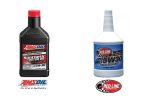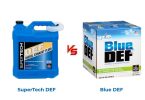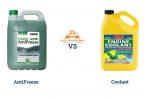0W-20 and 5W-20 are both multi-grade oils. Among gasoline and diesel engines, they’re popular because of the variety of benefits they offer.
0W-20 & 5W-20 oil differ from each other in terms of viscosity, performance, fuel economy, and price.
What is 0W20 oil?

Oil with the 0W-20 viscosity grade performs well in cold temperatures. Cold starting is much easier and it is a good lubricant for engine parts.
In cold climates, 0W-20 oil flows very quickly and without causing much friction that makes it ideal for driving in cold temperatures.
Features of 0W20 oil
- Precisely balanced
- Thermal and oxidation stability
- Low viscosity
- Low-temperature capabilities
- Performs as well in summer as it does in winter climates
Disadvantages of 0W20 oil
- Slightly more expensive
- The base oils and additives contained in 0W SAE oils are always synthetic or semisynthetic
What is 5W20 oil?

Oils with a viscosity of 5W20 are primarily winter oils. When operating in high temperatures, 5W20 oil remains relatively thin. It still provides decent lubrication and protection when operated at a moderate temperature.
You might want to switch to a higher oil viscosity grade if you drive in extremely hot climates and temperatures.
Features of 5W20 oil
- Excellent cold start protection
- The formula flows extremely fast
- Cleans the engine well
- Provides excellent thermal stability and oxidation control
Disadvantages of 5W20 oil
- Not good for heavy-duty diesel engines
- Only recommended for colder climates
- Not suitable for older vehicles
- Oil doesn’t flow as good at startup
0w20 vs 5w20 Oil: How Do They Differ?
A quick look
| Comparing factors | 0w20 | 5w20 |
| Viscosity | Low | High |
| Cranking Viscosity | 6200 at -35°C | 6600 at -30°C |
| Pumping Viscosity | 60 000 at -40°C | 60 000 at -35°C |
| Thickness | Low | High |
| Flow rate | High | Low |
| Startup performance in cold environment | Better | Worse |
| Climate preference | below freezing temperatures | seasonal climates (high temparetures) |
| Fuel economy | Lower | Higher |
| Circulation speed | faster | slower |
| Resistant to oil thinning | Low | High |
| Carbon emission | Low | High |
| Price | Slightly expensive | Cheaper |
| Recommended for | Diesel and gasoline engines | Light-duty petrol and gasoline engines |
Under Hot viscosity
Both oils can be used at warmer temperatures as SAE 20 weight oils.
Aside from providing decent fuel consumption, they also lubricate all of your engine’s critical parts for better fuel economy.
Both grades are tolerant of temperatures as high as 68 °F. High oil pressure and warmer temperatures do not cause extra oil intake or oil burning problems.
Under cold viscosity
Viscosity measures how well oil flows. It also describes how thick the oil is at various temperatures.
If you’re running the oil at cold temperatures, it will act like SAE 0W weight oil. By comparison, 5W-20 oil corresponds to SAE 5W weight.
A lower number will designate motor oils that perform better at cold temperatures before the ‘W’ in SAE terminology.
5W-20 is far thicker than 0W20. It flows smoothly through the critical engine parts at cold temperatures and is more stable.
With a viscosity of 5W-20, the oil is better suited to normal operating temperatures between -22°F and 68°F.
Fuel economy
Despite both 5W20 and 0W20 being usable at 20°C/68°F, 0W20 is thinner than 5W20 when the temperature is cold. In particular, when your car is initially started.
The 5W20 is what most new cars use because it provides a little better fuel economy. Also suitable for turbodiesel engines is the 0W20 variant.
Performance
It is best to use 5W-20 and 0W-20 in low-temperature climates during the winter.
Cold starts are better with 0W-20 oil (because of the lower viscosity). It also prevents low oil pressure, varnish deposits, sludge buildup, and engine wear.
With 0W-20, the oil will circulate faster and flow smoother.
0W-20 oil will be good for you if you drive a lot in below-freezing temperatures and rarely drive in warmer temperatures.
Meanwhile, 5W-20 is viscosier and slightly better suited for seasonal climates. The oil is thicker and better at resisting oil thinning when it gets hot.
Pricing
The price of 0W-20 oil is typically slightly higher than that of 5W-20 oil. The reason is that full or semi-synthetic oils are more stable than their counterparts.
Suppliers also charge different prices for engine oil. Consult your mechanic before choosing the best-priced option for your car.
0W20 vs 5W20 Oil: The Similarities
Multi-grade oils
Viscosity grades refer to engine oil grades.
There are many viscosity grades 11, to be exact. They start at 0W to 25W, then from 20 up to 60.
You can figure out how well an oil will perform at various temperatures by looking at the grades.
Both oils are multi-grade, which means they are suitable for both hot and cold temperatures.
In the 0w20, the W stands for winter. This makes it a great choice for people who live in cold climates. With an operating heat of 20 degrees, the 5w20 is well suited to cool climates.
Due to these values, both oils will have less density at low temperatures. Due to this quality, they are ideal for engines since they are able to move freely within the engine, preventing friction and dissipating heat.
With a lower grade, the 0w20 will perform better in colder temperatures than the 5w20
The “W20” meaning
Oils are characterized by their viscosity and weight (also thickness). Both varieties display the W symbol, which denotes cold-temperature suitability.
0W20 represents an oil with zero viscosity at cold temperatures and 20 viscosity at operating temperatures. In cold temperatures, 5W20 oil has a viscosity of 5.
Single-grade vs multi-grade oil
A viscosity grade can be single or multigrade. There are 11 viscosity grades in total for single-grade motor oils: from 0W up to 50, with 60 being the high-temperature grades.
They are also known as straight-weight oils because they cannot use viscosity modifiers. On the other hand, a multigrade oil has polymers that allow the oil to function at a wide temperature range.
Here you would have base-grade viscosity levels when the climate is cold. The second grade comes into play when it’s hot.
In other words, SAE 5W20 would be a cold-temperature oil that behaves like SAE 5. Then similar to an SAE 20 at high temps of (212 °F).
Can they be interchanged?
In most cases, 0W20 and 5W20 are interchangeable. 5W20 can withstand temperatures of -25° to 20° while 0W20 can withstand temperatures of -40° to 20°.
In severe cold regions, where temperatures can go below minus 25°, the best option is 0W20.
You can interchange the oil if the weather does not get that cold.
However, it’s best to use the 0W version in extreme weather conditions since the 5W version may have difficulty starting in low temperatures.
Which Do You Choose?
For the location
0W20 and 5W20 motor oils fall within almost the same temperature range, so you must consider where you will use the vehicle. Having this information means two things:
When living in a very cold place like Alaska or Maine, you should use 0W20 oil.
Neither 0W20 nor 5W20 can be used in Florida, where the temperature exceeds 20°C/68°F.
Testing for quality
Any oil brand displaying the starburst symbol and the API donut will have the correct viscosity grade.
The starburst symbol means that it has been passed through the test that is listed for the SL service.
You will see the API donut on your motor oil if it has been tested and passed the SL service rating.
Requirements of the manufacturer
As a rule, machine designers recommend high viscosity motor oils. The oil should be heavy like honey if your vehicle is heavily loaded.
However, a fast-moving lubricant is more appropriate when it runs very fast.
Read the manual
A simple but often overlooked task is reading your car owner’s manual.
First, check your manual to find out what motor oil viscosity is recommended for your car.
If both are on the list, use 0W20 and 5W20 alternately, depending on weather conditions.
FAQs
1. Can the wrong oil damage my engine?
Ans. You won’t notice any immediate damage to your engine but it will result in engine wear. It’s simple to drain the oil if you accidentally added the wrong oil. If you use an oil thinner than that recommended, you could void the warranty on your car.
It can also affect its fuel economy and oil consumption. You might damage your car parts, cause excessive wear on your engine, and experience extreme oil pressure issues if you add heavier oil because of the difference in viscosity levels.
2. Can I change oil brands?
Ans. 0W20 and 5W20 oils have similar viscosities when at operating temperatures. It shouldn’t make a difference in which oil you use.
3. Is 5W20 suitable for summer use?
Ans. Not really because hotter conditions cause 5w20 to thin out quickly.










Leave a Comment